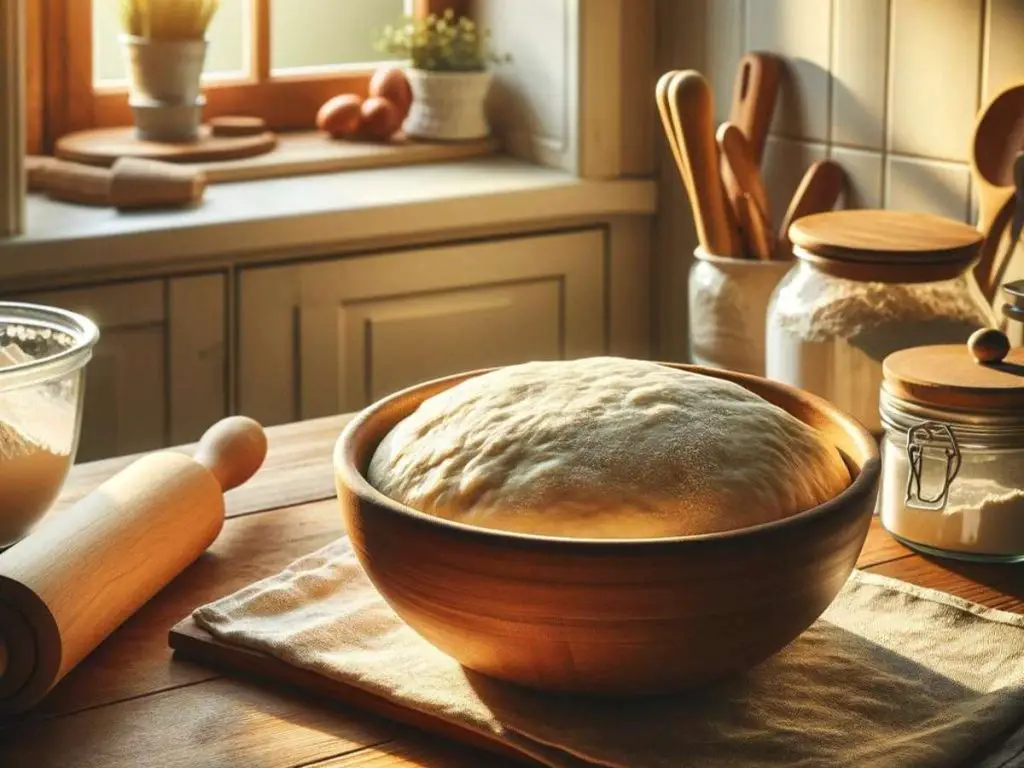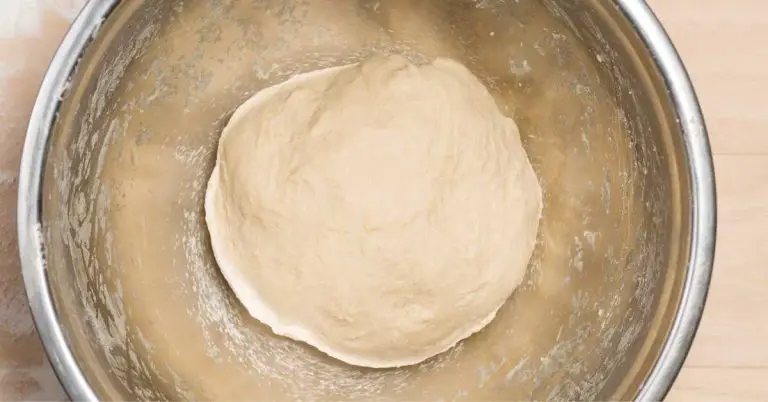Best Temperature For Pizza Dough To Rise: A Guide To Perfect Yeast Development
When it comes to making pizza dough, the temperature isn’t just a detail—it’s a game-changer. The dough’s journey from flour to delicious crust hinges on the right heat conditions. The pivotal role of temperature in yeast activation can’t be overstated.
The best temperature for pizza dough to rise is between 80°F and 90°F (26°C to 32°C). At this range, the yeast fermentation works optimally, ensuring your dough rises just right. However, in most cases, normal room temperature works just fine as well.
It’s a delicate balance: too hot, and you’ll kill the yeast, too cold and it won’t rise at all. Stick around, and let’s delve into how this temperature window influences everything from dough consistency to the final proofing stage.

Understanding Dough Temperature
In the world of dough, it’s essential to understand why temperature is such a crucial player. Temperature isn’t just about warmth, it’s about creating the ideal conditions for yeast to work its magic.
Yeast (the backbone of the dough) is highly sensitive to temperature. The right temperature ensures yeast ferments the dough sufficiently, contributing to both texture and taste.
At the optimal range between 80°F to 90°F (26°C to 32°C), yeast activity is consistent and effective. This consistency is key in pizza dough, as it leads to a uniform texture and a perfect rise every time. Get this right, and you’re halfway to baking sourdough bread or crafting a perfect pizza crust.
Maintaining the right temperature for your dough isn’t just about the ambient temperature of the room, it’s about the temperature of the dough itself. This is where a kitchen thermometer can be useful.
By monitoring the dough’s temperature, you ensure it remains within the desired range, preventing any surprises during the rise or bake. Remember, the temperature you measure in your dough ball directly influences the final product’s consistency and flavor.
How Long To Let Pizza Dough Rise
The time required for pizza dough to rise can vary significantly based on several factors, including the recipe, temperature, humidity, and desired flavor profile.
A general guideline I recommend is to allow pizza dough to rise for about 2 to 3 hours at room temperature before putting it in the fridge to cold ferment overnight. If the conditions are ideal, with a temperature of 80-90°F and humidity of 70-80%, the dough may rise in as little as 1-2 hours.
For a longer, slower rise for a more complex flavor, you can let the dough rise for 6-8 hours at room temperature, or up to 24 hours in the refrigerator. Some people even prefer a more extended rise of up to 72 hours or more for an even better flavor profile.
Cheat Sheet for Pizza Dough Rising Temperatures
To help you navigate the crucial stages of pizza dough preparation, here’s a reference chart. This chart is designed to guide you through the different temperature stages, from mixing to the final rise, ensuring you maintain the optimal conditions for your dough.
| Stage | Temperature Range | Description |
|---|---|---|
| Mixing Stage | 70°F to 75°F (21°C to 24°C) | Aim for a dough temperature of around 70°F to 75°F (21°C to 24°C). This slightly cooler temperature helps manage the dough’s consistency and makes it easier to handle. |
| First Rise (Bulk Fermentation) | 80°F to 90°F (26°C to 32°C) | This is where our key range of 80°F to 90°F (26°C to 32°C) comes into play. Keeping the dough within this window ensures a timely and effective rise, setting the stage for texture and flavor development. |
| Proofing Stage | 75°F to 80°F (24°C to 27°C) | After dividing your dough into individual balls, maintain a temperature of around 75°F to 80°F (24°C to 27°C). This slightly cooler range compared to the bulk rise helps control the fermentation rate and shapes the final texture. |
| Baking Stage | 450°F to 500°F (232°C to 260°C) | The oven temperature is crucial and should be as high as your oven allows, typically around 450°F to 500°F (232°C to 260°C). This high heat creates the perfect crust, crisp on the outside, soft and chewy inside. |
Remember, these temperatures are a guide. Factors like the specific recipe, flour type, and kitchen conditions can influence the exact temperatures you’ll need. Use this chart as a starting point and adjust based on your experience and the results you desire.
Temperature For Proofing Pizza Dough
When it comes to proofing pizza dough, temperature plays a critical role. The proofing stage is all about letting the dough rise at the right pace, and the temperature you choose can make or break this process.
So, what temperature do you proof pizza dough at? Ideally, you should proof your pizza dough at a slightly cooler temperature than the bulk rise, typically around 75°F to 80°F (24°C to 27°C), or average room temperature.
At this temperature range, the yeast remains active but doesn’t speed up too much, allowing the dough to develop flavor and texture gradually. This gradual rise is crucial for creating a pizza dough with the perfect chew and a flavor profile that can only be described as artisanal.
Creating the perfect environment for dough proofing doesn’t require fancy equipment. Simple tricks like using a warm (but not hot) oven with the light on, a microwave with a cup of hot water, or even a spot near a heater can help maintain the ideal proofing temperature.
The goal is to create a consistent, warm environment that encourages the yeast to do its job without rushing it.
Remember, proofing is as much about time as it is about temperature. While warmer temperatures can speed up the process, they might compromise the dough’s flavor and texture. On the flip side, cooler temperatures can make for a longer proof but often result in a more developed taste and robust gluten structure.

Temperature Variation During Bulk Yeast Fermenting
Letting your pizza dough rise in the fridge, also known as cold fermentation, is a slow process but with a significant payoff in flavor and texture at the end. The dough develops a more complex taste and a sturdy structure, ideal for a gourmet-style pizza.
By contrast, letting your dough rise at room temperature is a quicker method. It’s convenient and efficient, especially if you’re pressed for time. However, the trade-off is a less complex flavor profile compared to the dough fermented in the fridge.
Temperature variations can be leveraged to fit your baking schedule. If you plan ahead, using the refrigerator for a slow, extended rise can result in a pizza dough that’s rich in flavor and perfect for a special occasion. This is how I prefer to do it.
But, if you’re in a rush, a room temperature rise can still make delicious pizza as well. Preparing a dough starter in advance (such as a poolish preferment) can also help speed up the process.
Each method has its benefits and drawbacks. The key is to understand how these temperature variations impact the yeast activity and, consequently, the dough’s development. Adjusting your rising times based on these variations can help you achieve the desired outcome.
Using A Thermometer To Monitor Dough Temps
Accuracy in temperature is crucial for perfect pizza dough, and this is where thermometers and various tools can come into play. For many, a good kitchen thermometer is indispensable for monitoring the temperature of your dough.
Using a thermometer, you can measure the internal temperature at the center of the dough at various stages ensuring it stays within the desired range. This accuracy is particularly important when dealing with variations like cold fermentation in the fridge or a quick rise at room temperature.
Just be advised not to insert the thermometer into the dough when it’s at the proofing stage, or you risk disrupting the yeast and gluten development.
All that said, once you get the hang of what works, you don’t really need a thermometer at all. Personally, I never use one since I have a feel for what works and what doesn’t.
Other Useful Kitchen Tools For Keeping Pizza Dough Warm
Beyond thermometers, other tools can help maintain the ideal dough temperature as well. For example, a dough proofer or a warm container can provide a consistent environment for the dough to rise.
Even without specialized equipment, simple home solutions like a warm oven (turned off with the light on) or a spot near an ambient heat source can work effectively. And if you don’t have a proofer, a round plastic container (or covered bowl) in a warm spot also works well.
These tools and techniques are about more than just convenience, they’re about control. By closely monitoring and regulating the temperature, you ensure that your dough will ferment and rise as desired, creating the perfect base for your pizza.
Consistency in temperature leads to consistency in results, allowing you to replicate your success with each batch of dough.
Final Thoughts:
In the journey of crafting the perfect pizza, understanding the role of temperature in dough rise is fundamental.
To recap, the best temperature for pizza dough to rise is between 80°F and 90°F (26°C to 32°C). If that’s not possible (or you don’t know the temperature of your room), normal room temperature works fine as well.
This range ensures optimal yeast activity, leading to a perfect rise and a delicious final product. Whether you choose to let your dough rise in the fridge for a slow fermentation or at room temperature for a quicker process, the key is to maintain control over the temperature to achieve the results you desire.






